Kites Bring Joy In Rohingya Refugee Camp
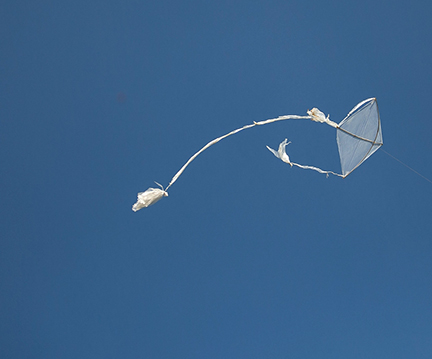
Joy can be difficult to find for many children. It is especially so when they are contained in refugee camps for any one of the many hundreds of reasons that such camps are established around the world.
Why political decisions are made to virtually imprison families in such camps is not up for discussion here. It is well known what hardships such camps impose on families and how the lives of children in such circumstances can be filled with hardships.
What is amazing is the resiliency of the human spirit even in the young. There is an inherent desire to find ways to create things and to find some joy in life. There are very few things that can bring more joy to a child than the flight of a kite and the feeling of a kite line in the hand as the kite dances free in the sky above.

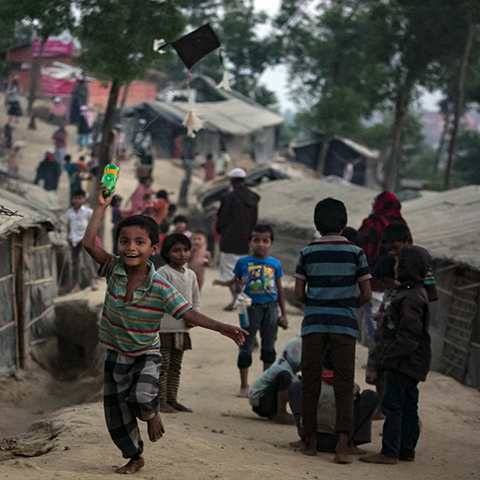
Visit the NPR story here: A 10-Year-Old Kid Is Making Magic With His Kites - Jason Beaubien.
The Tukkal - A 'Heavy Duty' Fighter Kite
Kite fighting is done in many countries around the globe. Countries most noted for fighting kites using line cutting techniques to determine a winner are Afghanistan, Bangladesh, India, Nepal, Pakistan in central Asia and the sub-continent, as well as Vietnam, Korea, Thailand in east Asia, and Brazil in South America.
Most fighter kites are light and nimble. They race and dart across the sky in the hands of skilled pilots seeking to catch another fighter kite in a precarious position and cut the flying line of the opponent. There are several varieties of these light and fast fighter kites that are flown in India, Pakistan, Afghanistan, Bangladesh, Nepal, Brazil, Japan, and Korea.
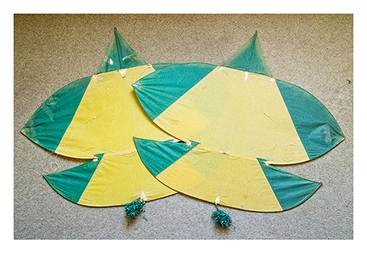 The name Tukkal means "lantern" because the kite originally was built to lift lanterns into the night sky. These big, flat fighters were designed with lifting a load in mind.
The name Tukkal means "lantern" because the kite originally was built to lift lanterns into the night sky. These big, flat fighters were designed with lifting a load in mind.
The Tukal is perhaps the heaviest of all fighter kites. It is a heavier pulling kite and as such usually requires a heavier flying line to withstand the greater pull that it generates in flight. As such, the Tukal is not typically as nimble as other fighter kites. It is, however, this characteristic that helps the Tukal to prevail in many battles. It's strong pull puts a great deal of tension on the flying line and that helps it to quickly cut through the line of opposing kites in battle. Getting into a cutting position, depends on the skill of the flyer who must compensate for the lack of agility of this kite by being ever vigilant as to its position in the battle.
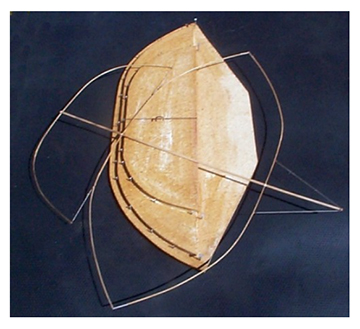 Tukkal frame of shaped bamboo. Shown with a plywood form used for shaping the frame. From: Stan Keller, Kite Plan Base. Framed with three heat-shaped bows, a spine and string supports, the Tukal is immediately heavier than the typical fighter kite composed of a spine and a single, slender bow. The sail material is coloured tissue paper which also adorns the lighter faster fighter kites.
Tukkal frame of shaped bamboo. Shown with a plywood form used for shaping the frame. From: Stan Keller, Kite Plan Base. Framed with three heat-shaped bows, a spine and string supports, the Tukal is immediately heavier than the typical fighter kite composed of a spine and a single, slender bow. The sail material is coloured tissue paper which also adorns the lighter faster fighter kites.
A plan for a Tukkal can be found at the Kite Plan Base website. For convenience, a copy from Stan Kellar's plans can be found here.
[Credits: Information research from Stan Keller at Kite Plan Base and Pelham, David. The Penguin Book of Kites.Penguin Books Ltd., Middlesex, England. Page 12.]
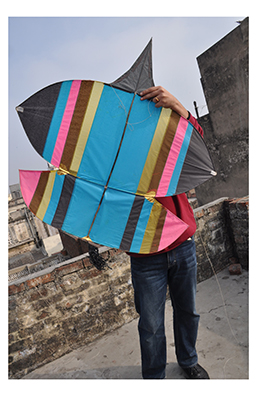 Credit: Photo of Tukkal - by G. Graves from his Flckr collection.
Credit: Photo of Tukkal - by G. Graves from his Flckr collection.
Soaring Kites at Blue Hill Test Marconi-type Wireless Signals -1899
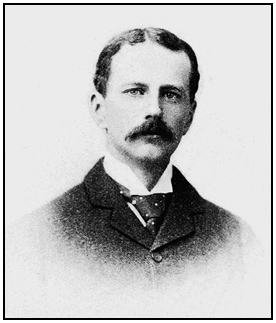 During August of 1899 Lawrence Rotch, meteorologist and founder of the Blue Hill Meteorological Observatory in Milton, a suburb of Boston, carried out some cutting edge experiments with wireless signalling. This experimentation was conducted during what were the very early stages of wireless signalling when there were still some developmental challenges being worked out in the process of wireless messaging.
During August of 1899 Lawrence Rotch, meteorologist and founder of the Blue Hill Meteorological Observatory in Milton, a suburb of Boston, carried out some cutting edge experiments with wireless signalling. This experimentation was conducted during what were the very early stages of wireless signalling when there were still some developmental challenges being worked out in the process of wireless messaging.
The primary developers of wireless communication technology were Guglielmo Marconi and Karl Ferdinand Braun. Marconi, the famous Italian inventor, was working on his technology primarily out of Great Britain while Braun was focusing his work within his native Germany. The competing leaders in this new technology were stirring up public interest through newspaper accounts of their progress. Scientific practitioners in many fields were keenly aware of the developing technology and were seeking to understand and employ it as well.

Lawrence Rotch, a pioneer in meteorological science, had founded the Blue Hill Observatory in 1884. Blue Hill "... was the scene of many of the first scientific measurements of upper atmosphere weather conditions, using kites to carry weather instruments aloft. Knowledge of wind velocities, air temperature and relative humidity at various levels came into use as vital elements in weather prediction due to techniques developed at this site. By 1895 the observatory was the source of weather forecasts of remarkable accuracy. On October 8, 1896, a record of 8740 feet was achieved for a weather kite."1
The kites of William Abner Eddy had been flown here in 1895 and many firsts and records were set with Eddy's kites. Soon thereafter the Observatory began to settle on the kites of Lawrence Hargrave as the predominant lifting tool for experiments. Several modifications to the Hargrave design were carried our by W. H. Clayton of the Observatory staff and by late 1896 the Hargrave-Clayton hybrid kite was the one predominantly in use.
Rotch's experiment with wireless signalling involved sending up a kite with a copper wire antenna connected to the Blue Hill building and a Morse transmitter inside. From August 10-12, 1899 Rotch was successful in sending signals from the kite above Blue Hill to a receiving station on Mt. Chickatawbut, a distance of three miles away2.
Based on the success of the early tests, Rotch planned to increase the distance in future tests to attempt to reach a receiving station twelve miles away on the Harvard Memorial Tower in Cambridge.
Scientific interest in wireless signalling was very high in 1899. Newspapers in America, England and Europe were following the developments of Guglielmo Marconi and Ferdinand Braun (Germany) as they pushed forward the frontiers of the new technology.
Men of science and invention were watching carefully and anxiously wanted to learn more about wireless signals. Professor Samuel Langley of the Smithsonian Institution suggested to W.H. Clayton that perhaps Blue Hill with its natural elevation and infrastructure to support kite technology (power winches, heavy line, wire, and a vast array of kites of varying sizes and lifting capability) could be a place to test out some of the theories and work being done by Marconi in broadcasting wireless signals.
Clayton took the idea to Rotch and a series of experiments for August 1899 was explored. Rotch, assisted by his assistant, a Mr. Picard, worked with Professor Sabine of Harvard to devise the experiments and undertake the tests.
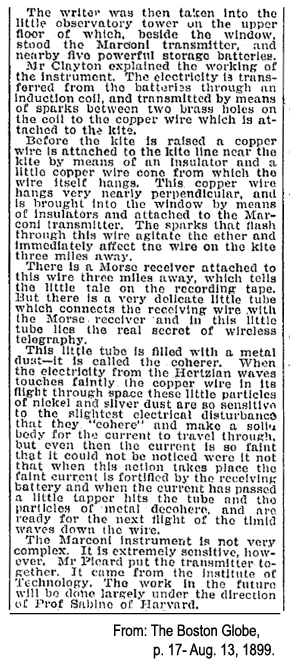 The staff reporter for the Boston Globe gave an excellent description of the wireless equipment that was used in the experiment. It provides insight into the early equipment and power supplies used in the infancy of wireless communcation technology. The description, when compared to notes about early equipment used by Marconi in his experiments in England, shows marked similarities to the Marconi devices, thus leading to the conclusion that published reports of Marconi's work were a guide to the Blue Hill experiments. It is unlikely that Rotch would have received information about the equipment directly from Marconi since patent applications and the necessity of keeping a leading edge in the development of the new technology would have prevented any disclosure to portential rivals.
The staff reporter for the Boston Globe gave an excellent description of the wireless equipment that was used in the experiment. It provides insight into the early equipment and power supplies used in the infancy of wireless communcation technology. The description, when compared to notes about early equipment used by Marconi in his experiments in England, shows marked similarities to the Marconi devices, thus leading to the conclusion that published reports of Marconi's work were a guide to the Blue Hill experiments. It is unlikely that Rotch would have received information about the equipment directly from Marconi since patent applications and the necessity of keeping a leading edge in the development of the new technology would have prevented any disclosure to portential rivals.
Rotch and Picard encountered one of the common distractors of early wireless telegraphy in their experiments: that of static electricity. He noted to the Globe reporter that he was hopeful that Prof. Sabine of Harvard would be able to help solve the distraction of static to the messaging system that they were working on. Later in the development of wireless systems, Marconi and Braun would learn to tune their frequency transmission and reception in a manner that would filter out most of the static distraction from the wide band frequencies that were then in use.
On December 12, 1901 Guglielmo Marconi sent a wireless signal across the Atlantic Ocean from a transmitting station in Poldhu, Cornwall to an antenna suspended from a kite at Signal Hill, St. Johns, Newfoundland. Long distance wireless transmission capability was proven; the era of wireless communication was now proven and only needed refinement for widespread use.
__________
Notes:
1. Wikipedia contributors, "Blue Hill Meteorological Observatory," Wikipedia, The Free Encyclopedia, http://en.wikipedia.org/w/index.php?title=Blue_Hill_Meteorological_Observatory&oldid=577737496 (accessed January 31, 2014).
2. "Blue Hill's Wireless Messages." The Boston Globe, Boston MA. Aug. 13, 1899. Page 17.
Using large Hargrave kites,
Brazilian Kites Highlighted During 2014 World Cup
As the world's focus turned to Brazil in June and July of 2014 for the World Cup, attention was also brought to everyday life in Brazil.
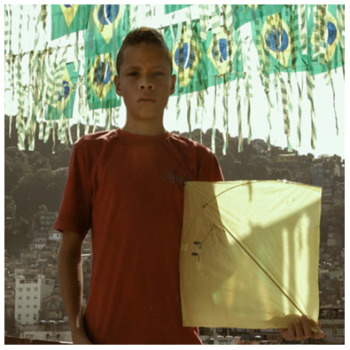 The New York Times published regular feature stories on aspects of life in Brazil. Often these stories showed the wide discrepancy of living conditions in the diverse economic conditions of the nation's largest cities.
The New York Times published regular feature stories on aspects of life in Brazil. Often these stories showed the wide discrepancy of living conditions in the diverse economic conditions of the nation's largest cities.
In a July 15, 2014 article entitled Kite Fight, correspondent Guillerme Tensol wrote about the passion that young Brazilians have for making, flying and fighting kites over the rooftops of their homes.
"After futebol, kite fighting is one of Brazil’s most popular sports. In the crowded urban favelas, flying a kite (or pipa) is more than a leisurely escape from harsh living conditions; it’s also a form of battle, with the sky an arena."
The Brazillian Pipa (kite) resembles a typical Indian fighter kite, or patang, in both shape and general dimensions. The frame is also similar to that of an Indian fighter kite.
Besides making the kites themselves, the young kite builders pound glass shards into a fine powder, wax their line and add the powdered glass to coat it. The complete kite fighting system is totally manufactured by the young builders using either paper or plastic shopping bags for the kite sails. For kite line reels a tin can is used to carefully wind the fighting line when the kite is not in flight. All materials are easily gathered from repurposed items that are readily or cheaply available.
 In addition to the brief article in The Times, a wonderful video documentary was produced about the Pipa, the kite fighting culture, and the skilled young artisans who craft their own kites.
In addition to the brief article in The Times, a wonderful video documentary was produced about the Pipa, the kite fighting culture, and the skilled young artisans who craft their own kites.
The video (linked here for viewing) is a compelling overview of life in Rocinha, Rio de Janeiro’s largest economically depressed community.
The simple beauty of kite construction and the skill of the kite fighters is beautifully captured in the video collaboration between the sports magazine Victory and the Brazilian production company Mosquito Project.
_____________
Note: See references to this article for attribution to source materials used. Copyright is held by The New York Times. The use of the materials in this post is intended to bring the information to a wider audience and educate readers about the use of kites in Brazil.
Ahmedabad India's Kite Festival Rules the Skies.
The Ahmedabad International Festival is considered by many kiters to be the world's largest annual kite flying event.
Located in the state of Gujarat, Ahmedabad has a hot semi-arid climate with marginally less rain than required for a tropical savanna climate. There are three main seasons: summer, monsoon and winter. Aside from the monsoon season, the climate is extremely dry with mean monthly temperatures ranging from 20 degrees to 33 degrees Celsius throughout the year. January is the coolest month and the cultural festival of Uttarayana held on January 14-15 celebrates the movement of the sun to the north.
 Patangs made and sold by local youth. Photo by Meena Kadri The Uttarayan festival traditionally features mass kite flying across the city. Young and old take their colourful patangs (kites) made from tissue paper and split bamboo and battle for supremacy above the streets of the city.
Patangs made and sold by local youth. Photo by Meena Kadri The Uttarayan festival traditionally features mass kite flying across the city. Young and old take their colourful patangs (kites) made from tissue paper and split bamboo and battle for supremacy above the streets of the city.
A thin cotton or hemp line is coated with a mixture of finely crushed glass and rice glue. In recent years, synthetic line has been coated with a variety of abrasives and stronger glue. Some instances of metallic lines have been reported in recent years.
The coated lines permit skilful fliers to cut one another's kites out of the sky. However, the fallen lines from cut kites can cause much harm to people who encounter them as they ride bicycles or motorcycles through the city streets.
The 2014 Ahmedabad Kite Festival has been beautifully captured in a video that shows the transition of the kite flying from daytime through to night. Traditional kite battles are replaced when darkens arrives by thousands of Chinese lantern balloons rising into the sky. This is one of the world's most sensational kiting events!




